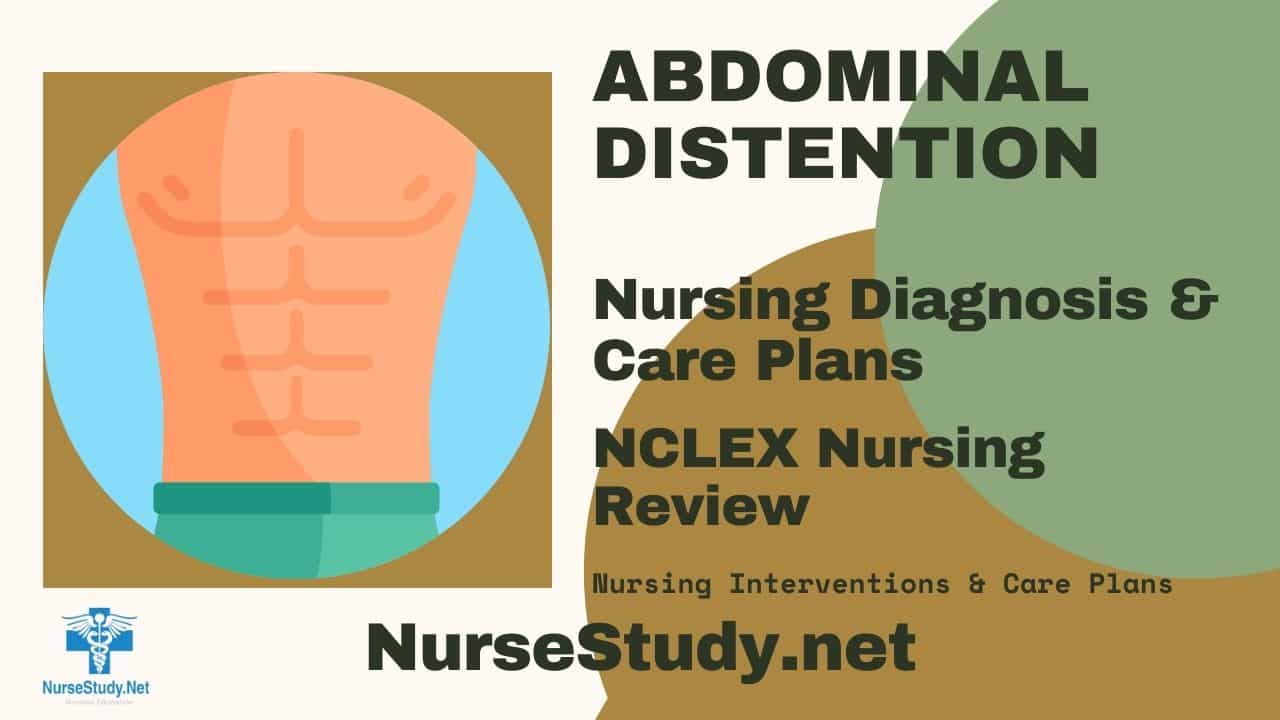Abdominal distention is a condition characterized by bloating and swelling of the abdomen, often accompanied by discomfort and pressure. This nursing diagnosis focuses on identifying causes, managing symptoms, and preventing complications associated with abdominal distention.
Causes (Related to)
Abdominal distention can occur due to various factors:
- Gastrointestinal conditions:
- Intestinal obstruction
- Constipation
- Irritable bowel syndrome
- Gastric outlet obstruction
- Gastroparesis
- Systemic conditions:
- Liver disease
- Heart failure
- Kidney disease
- Malnutrition
- Pregnancy
- Other factors:
- Medication side effects
- Poor dietary habits
- Fluid accumulation (ascites)
- Post-operative complications
- Tumors
Signs and Symptoms (As evidenced by)
Subjective: (Patient reports)
- The feeling of fullness or pressure
- Abdominal pain or discomfort
- Nausea
- Early satiety
- Decreased appetite
- Gas and bloating
- Changes in bowel habits
Objective: (Nurse assesses)
- Visible abdominal distention
- Increased abdominal girth
- Tympanic percussion sounds
- Altered bowel sounds
- Changes in vital signs
- Presence of ascites
- Decreased urine output
- Edema
Expected Outcomes
- The patient will demonstrate reduced abdominal distention.
- The patient will report decreased discomfort
- The patient will maintain adequate nutrition and hydration
- The patient will establish regular bowel patterns
- The patient will identify and avoid trigger factors
- Patient will demonstrate an understanding of management strategies
- The patient will maintain optimal functional status
Nursing Assessment
Monitor Vital Signs
- Check blood pressure, pulse, and respiratory rate
- Monitor the temperature for signs of infection
- Assess pain levels regularly
Assess Abdominal Status
- Measure abdominal girth
- Perform a thorough abdominal assessment
- Auscultate bowel sounds
- Check for tenderness and rigidity
- Document the character of distention
Evaluate Nutrition and Hydration
- Monitor intake and output
- Assess eating patterns
- Check for signs of malnutrition
- Document fluid balance
- Assess weight changes
Monitor for Complications
- Watch for signs of perforation
- Assess for peritonitis
- Monitor respiratory status
- Check for signs of organ compromise
- Evaluate circulation
Review Contributing Factors
- Assess medication history
- Document dietary habits
- Review medical history
- Check activity patterns
- Evaluate lifestyle factors
Nursing Care Plans
Nursing Care Plan 1: Acute Pain
Nursing Diagnosis Statement:
Acute Pain related to increased abdominal pressure and distention as evidenced by verbal reports of discomfort and guarding behavior.
Related Factors:
- Increased intra-abdominal pressure
- Organ displacement
- Tissue stretching
- Gas accumulation
Nursing Interventions and Rationales:
- Assess pain characteristics regularly
Rationale: Enables evaluation of interventions and condition progression - Position patient for comfort
Rationale: Reduces pressure and promotes comfort - Administer prescribed medications
Rationale: Manages pain and underlying causes
Desired Outcomes:
- The patient will report decreased pain levels
- The patient will demonstrate improved comfort
- The patient will maintain a functional activity level
Nursing Care Plan 2: Impaired Comfort
Nursing Diagnosis Statement:
Impaired Physical Comfort related to abdominal distention as evidenced by restlessness and reported discomfort.
Related Factors:
- Physical distention
- Altered eating patterns
- Environmental stressors
- Anxiety
Nursing Interventions and Rationales:
- Provide comfortable positioning
Rationale: Minimizes pressure on the abdomen - Implement comfort measures
Rationale: Promotes relaxation and reduces anxiety - Monitor environmental factors
Rationale: Creates optimal healing environment
Desired Outcomes:
- The patient will report improved comfort levels
- The patient will demonstrate reduced anxiety
- The patient will maintain adequate rest periods
Nursing Care Plan 3: Imbalanced Nutrition
Nursing Diagnosis Statement:
Imbalanced Nutrition: Less than Body Requirements related to early satiety and decreased appetite as evidenced by reduced oral intake.
Related Factors:
- Abdominal distention
- Early satiety
- Decreased appetite
- Nausea
Nursing Interventions and Rationales:
- Monitor nutritional intake
Rationale: Ensures adequate nutrition - Offer small, frequent meals
Rationale: Prevents overwhelming digestive system - Document weight changes
Rationale: Tracks nutritional status
Desired Outcomes:
- The patient will maintain adequate nutritional intake
- The patient will demonstrate weight stability
- The patient will report an improved appetite
Nursing Care Plan 4: Altered Elimination
Nursing Diagnosis Statement:
Constipation related to altered bowel motility as evidenced by reduced bowel movements and abdominal distention.
Related Factors:
- Decreased mobility
- Inadequate fluid intake
- Medication effects
- Altered bowel habits
Nursing Interventions and Rationales:
- Monitor bowel movements
Rationale: Tracks elimination patterns - Encourage mobility
Rationale: Promotes bowel motility - Ensure adequate hydration
Rationale: Facilitates normal bowel function
Desired Outcomes:
- The patient will establish a regular bowel pattern
- The patient will demonstrate improved elimination
- The patient will maintain adequate hydration
Nursing Care Plan 5: Activity Intolerance
Nursing Diagnosis Statement:
Activity Intolerance related to abdominal discomfort and distention as evidenced by fatigue and decreased activity levels.
Related Factors:
- Physical discomfort
- Reduced mobility
- Fatigue
- Altered nutrition
Nursing Interventions and Rationales:
- Assess activity tolerance
Rationale: Determines appropriate activity levels - Plan graduated activity
Rationale: Prevents overexertion - Monitor vital signs during activity
Rationale: Ensures safe activity progression
Desired Outcomes:
- The patient will demonstrate improved activity tolerance
- The patient will maintain the appropriate activity level
- The patient will report decreased fatigue
References
- Azpiroz F. Abdominal distention: old hypotheses and new concepts. Gastroenterology. 2006 Oct;131(4):1337-9. doi: 10.1053/j.gastro.2006.08.046. PMID: 17030200.
- Jha, A., Sapkota, H., Ghimire, P., Paudel, N., Ranabhat, R., & Jha, S. (2024). Ultrashort segment adult Hirschsprung disease: A case report of periodic abdominal distension and constipation spanning for more than 20 years. Radiology Case Reports, 19(11), 5328-5331. https://doi.org/10.1016/j.radcr.2024.08.011
- Kumar Arumugam S, Natarajan S, Ramalingam R, Kandasamy P. Recurrent Episodes of Abdominal Distention. Neoreviews. 2021 Jul;22(7):e492-e495. doi: 10.1542/neo.22-7-e492. PMID: 34210816.
- Moshiree B, Drossman D, Shaukat A. AGA Clinical Practice Update on Evaluation and Management of Belching, Abdominal Bloating, and Distention: Expert Review. Gastroenterology. 2023 Sep;165(3):791-800.e3. doi: 10.1053/j.gastro.2023.04.039. Epub 2023 Jul 13. PMID: 37452811.
- Silvestri, L. A. (2020). Saunders comprehensive review for the NCLEX-RN examination. St. Louis, MO: Elsevier.
